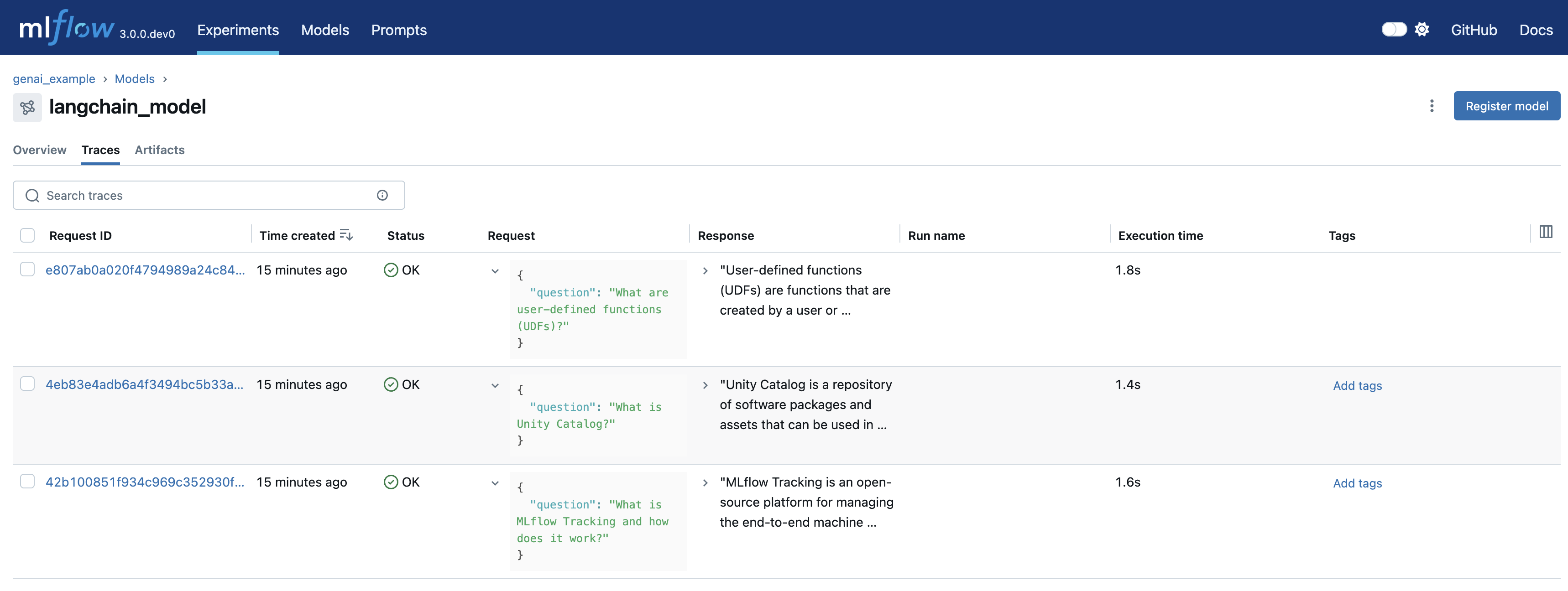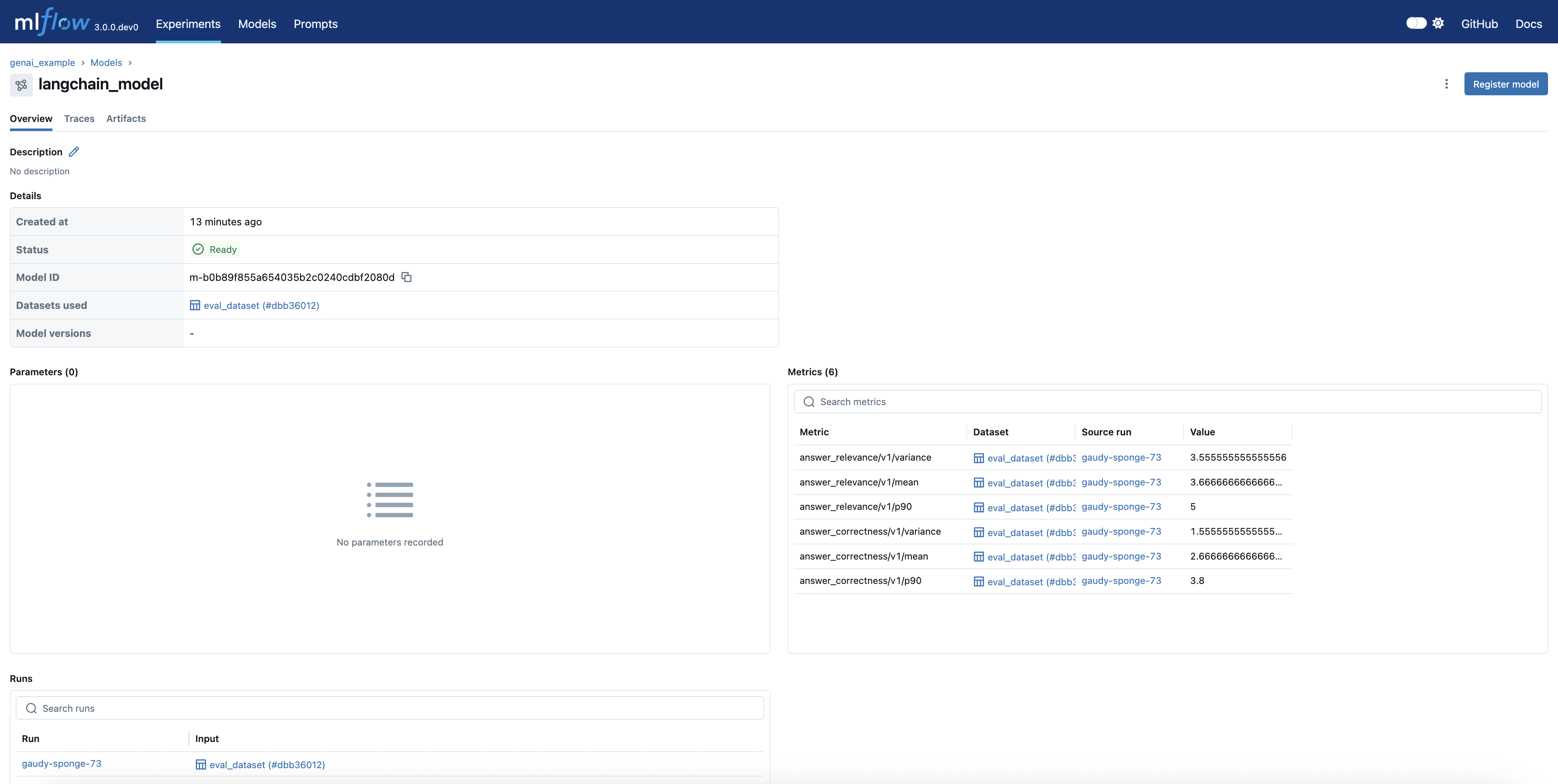MLflow 3 中的 GenAI Agent
先决条件
运行以下命令安装 MLflow 3 和 langchain-openai 包。
pip install --upgrade 'mlflow>=3.0.0rc0' --pre
pip install langchain-openai
在 CLI 中设置 OPENAI_API_KEY 环境变量以向 OpenAI API 进行身份验证。
export OPENAI_API_KEY=your_api_key_here
此示例演示了如何使用 MLflow 来跟踪和评估带有提示工程的 langchain 模型请求。它展示了如何注册提示、生成跟踪以及使用评估数据集评估响应性能。该示例还强调了跟踪交互式跟踪并将它们链接到已记录模型以获得更好可观察性的能力。
注册提示模板
首先,我们将提示模板注册为 MLflow 中的提示版本。这使我们能够跟踪和管理开发过程中使用的不同提示版本,确保可重现性和更好的可观察性。
import mlflow
system_prompt = mlflow.genai.register_prompt(
name="chatbot_prompt",
template="You are a chatbot that can answer questions about IT. Answer this question: {{question}}",
commit_message="Initial version of chatbot",
)
切换到“Prompts”选项卡以查看已注册的提示及其详细信息。

使用 Langchain 创建链
接下来,我们将使用上一步中注册的提示的 ChatPromptTemplate,并将其与 ChatOpenAI 结合,创建一个简单的链来回答用户问题。
from langchain.schema.output_parser import StrOutputParser
from langchain_core.prompts import ChatPromptTemplate
from langchain_openai import ChatOpenAI
prompt = ChatPromptTemplate.from_template(system_prompt.to_single_brace_format())
chain = prompt | ChatOpenAI(temperature=0.7) | StrOutputParser()
question = "What is MLflow?"
print(chain.invoke({"question": question}))
# MLflow is an open-source platform for managing the end-to-end machine learning lifecycle...
使用跟踪可观察性测试模型
在本节中,我们将使用示例查询手动测试模型,并利用 MLflow Tracing 来分析输出和调试潜在问题。作为设置的一部分,使用 mlflow.set_active_model() API 设置活动模型,以便将应用程序开发过程中生成的任何跟踪与其链接。 启用自动记录后,所有生成的跟踪都将链接到当前活动模型,从而确保无缝的可观察性。
# set the active model for linking traces
mlflow.set_active_model(name="langchain_model")
# Enable autologging so that interactive traces from the client are automatically linked to a LoggedModel
mlflow.langchain.autolog()
questions = [
"What is MLflow Tracking and how does it work?",
"What is Unity Catalog?",
"What are user-defined functions (UDFs)?",
]
outputs = []
for question in questions:
outputs.append(chain.invoke({"question": question}))
# fetch the current active model's id and check traces
active_model_id = mlflow.get_active_model_id()
mlflow.search_traces(model_id=active_model_id)
# trace_id trace ... assessments request_id
# 0 e807ab0a020f4794989a24c84c2892ad Trace(trace_id=e807ab0a020f4794989a24c84c2892ad) ... [] e807ab0a020f4794989a24c84c2892ad
# 1 4eb83e4adb6a4f3494bc5b33aca4e970 Trace(trace_id=4eb83e4adb6a4f3494bc5b33aca4e970) ... [] 4eb83e4adb6a4f3494bc5b33aca4e970
# 2 42b100851f934c969c352930f699308d Trace(trace_id=42b100851f934c969c352930f699308d) ... [] 42b100851f934c969c352930f699308d
查看实验中的“Models”选项卡,以查看名为 langchain_model 的新记录模型。

在“Logged Model”页面上,您可以查看详细信息,包括 model_id。

导航到模型页面的“Traces”选项卡,您可以查看刚刚生成的跟踪。

评估代理的性能
最后,我们使用 mlflow.evaluate() 来评估链在评估数据集上的性能。此步骤涉及计算其他指标,例如答案的正确性,以深入了解模型的行为和准确性。
# Prepare the eval dataset in a pandas DataFrame
import pandas as pd
eval_df = pd.DataFrame(
{
"messages": questions,
"expected_response": [
"""MLflow Tracking is a key component of the MLflow platform designed to record and manage machine learning experiments. It enables data scientists and engineers to log parameters, code versions, metrics, and artifacts in a systematic way, facilitating experiment tracking and reproducibility.\n\nHow It Works:\n\nAt the heart of MLflow Tracking is the concept of a run, which is an execution of a machine learning code. Each run can log the following:\n\nParameters: Input variables or hyperparameters used in the model (e.g., learning rate, number of trees). Metrics: Quantitative measures to evaluate the model's performance (e.g., accuracy, loss). Artifacts: Output files like models, datasets, or images generated during the run. Source Code: The version of the code or Git commit hash used. These logs are stored in a tracking server, which can be set up locally or on a remote server. The tracking server uses a backend storage (like a database or file system) to keep a record of all runs and their associated data.\n\n Users interact with MLflow Tracking through its APIs available in multiple languages (Python, R, Java, etc.). By invoking these APIs in the code, you can start and end runs, and log data as the experiment progresses. Additionally, MLflow offers autologging capabilities for popular machine learning libraries, automatically capturing relevant parameters and metrics without manual code changes.\n\nThe logged data can be visualized using the MLflow UI, a web-based interface that displays all experiments and runs. This UI allows you to compare runs side-by-side, filter results, and analyze performance metrics over time. It aids in identifying the best models and understanding the impact of different parameters.\n\nBy providing a structured way to record experiments, MLflow Tracking enhances collaboration among team members, ensures transparency, and makes it easier to reproduce results. It integrates seamlessly with other MLflow components like Projects and Model Registry, offering a comprehensive solution for managing the machine learning lifecycle.""",
"""Unity Catalog is a feature in Databricks that allows you to create a centralized inventory of your data assets, such as tables, views, and functions, and share them across different teams and projects. It enables easy discovery, collaboration, and reuse of data assets within your organization.\n\nWith Unity Catalog, you can:\n\n1. Create a single source of truth for your data assets: Unity Catalog acts as a central repository of all your data assets, making it easier to find and access the data you need.\n2. Improve collaboration: By providing a shared inventory of data assets, Unity Catalog enables data scientists, engineers, and other stakeholders to collaborate more effectively.\n3. Foster reuse of data assets: Unity Catalog encourages the reuse of existing data assets, reducing the need to create new assets from scratch and improving overall efficiency.\n4. Enhance data governance: Unity Catalog provides a clear view of data assets, enabling better data governance and compliance.\n\nUnity Catalog is particularly useful in large organizations where data is scattered across different teams, projects, and environments. It helps create a unified view of data assets, making it easier to work with data across different teams and projects.""",
"""User-defined functions (UDFs) in the context of Databricks and Apache Spark are custom functions that you can create to perform specific tasks on your data. These functions are written in a programming language such as Python, Java, Scala, or SQL, and can be used to extend the built-in functionality of Spark.\n\nUDFs can be used to perform complex data transformations, data cleaning, or to apply custom business logic to your data. Once defined, UDFs can be invoked in SQL queries or in DataFrame transformations, allowing you to reuse your custom logic across multiple queries and applications.\n\nTo use UDFs in Databricks, you first need to define them in a supported programming language, and then register them with the SparkSession. Once registered, UDFs can be used in SQL queries or DataFrame transformations like any other built-in function.\n\nHere\'s an example of how to define and register a UDF in Python:\n\n```python\nfrom pyspark.sql.functions import udf\nfrom pyspark.sql.types import IntegerType\n\n# Define the UDF function\ndef multiply_by_two(value):\n return value * 2\n\n# Register the UDF with the SparkSession\nmultiply_udf = udf(multiply_by_two, IntegerType())\n\n# Use the UDF in a DataFrame transformation\ndata = spark.range(10)\nresult = data.withColumn("multiplied", multiply_udf(data.id))\nresult.show()\n```\n\nIn this example, we define a UDF called `multiply_by_two` that multiplies a given value by two. We then register this UDF with the SparkSession using the `udf` function, and use it in a DataFrame transformation to multiply the `id` column of a DataFrame by two.""",
],
"predictions": outputs,
}
)
# Start a run to represent the evaluation job
with mlflow.start_run() as evaluation_run:
eval_dataset = mlflow.data.from_pandas(
df=eval_df,
name="eval_dataset",
targets="expected_response",
predictions="predictions",
)
mlflow.log_input(dataset=eval_dataset)
# Run the evaluation based on extra metrics
# Current active model will be automatically used
result = mlflow.evaluate(
data=eval_dataset,
extra_metrics=[
mlflow.metrics.genai.answer_correctness("openai:/gpt-4o"),
mlflow.metrics.genai.answer_relevance("openai:/gpt-4o"),
],
# This is needed since answer_correctness looks for 'inputs' field
evaluator_config={"col_mapping": {"inputs": "messages"}},
)
result.tables["eval_results_table"]
# messages ... answer_relevance/v1/justification
# 0 What is MLflow Tracking and how does it work? ... The output directly addresses the input questi...
# 1 What is Unity Catalog? ... The output is completely irrelevant to the inp...
# 2 What are user-defined functions (UDFs)? ... The output directly addresses the input questi...
导航到活动模型,您可以在 MLflow UI 中看到显示的指标及其详细信息。这包括诸如答案正确性和答案相关性等指标,从而提供对模型性能的洞察。
